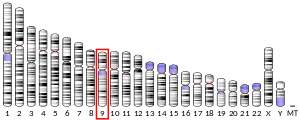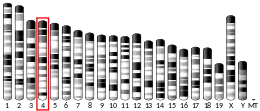CDKN2B
Cyclin-dependent kinase 4 inhibitor B also known as multiple tumor suppressor 2 (MTS-2) or p15INK4b is a protein that is encoded by the CDKN2B gene in humans.[5][6]
Function
This gene lies adjacent to the tumor suppressor gene CDKN2A in a region that is frequently mutated and deleted in a wide variety of tumors. This gene encodes a cyclin-dependent kinase inhibitor, also known as p15Ink4b protein, which forms a complex with CDK4 or CDK6, and prevents the activation of the CDK kinases by cyclin D, thus the encoded protein functions as a cell growth regulator that inhibits cell cycle G1 progression. The expression of this gene was found to be dramatically induced by TGF beta, which suggested its role in the TGF beta induced growth inhibition. Two alternatively spliced transcript variants of this gene, which encode distinct proteins, have been reported.[6]
Interactions
CDKN2B has been shown to interact with cyclin-dependent kinase 4.[7][8]
References
- GRCh38: Ensembl release 89: ENSG00000147883 - Ensembl, May 2017
- GRCm38: Ensembl release 89: ENSMUSG00000073802 - Ensembl, May 2017
- "Human PubMed Reference:". National Center for Biotechnology Information, U.S. National Library of Medicine.
- "Mouse PubMed Reference:". National Center for Biotechnology Information, U.S. National Library of Medicine.
- Hannon GJ, Beach D (October 1994). "p15INK4B is a potential effector of TGF-beta-induced cell cycle arrest". Nature. 371 (6494): 257–61. doi:10.1038/371257a0. PMID 8078588. S2CID 4268054.
- "Entrez Gene: CDKN2B cyclin-dependent kinase inhibitor 2B (p15, inhibits CDK4)".
- Rual JF, Venkatesan K, Hao T, Hirozane-Kishikawa T, Dricot A, Li N, Berriz GF, Gibbons FD, Dreze M, Ayivi-Guedehoussou N, Klitgord N, Simon C, Boxem M, Milstein S, Rosenberg J, Goldberg DS, Zhang LV, Wong SL, Franklin G, Li S, Albala JS, Lim J, Fraughton C, Llamosas E, Cevik S, Bex C, Lamesch P, Sikorski RS, Vandenhaute J, Zoghbi HY, Smolyar A, Bosak S, Sequerra R, Doucette-Stamm L, Cusick ME, Hill DE, Roth FP, Vidal M (October 2005). "Towards a proteome-scale map of the human protein-protein interaction network". Nature. 437 (7062): 1173–8. doi:10.1038/nature04209. PMID 16189514. S2CID 4427026.
- Stelzl U, Worm U, Lalowski M, Haenig C, Brembeck FH, Goehler H, Stroedicke M, Zenkner M, Schoenherr A, Koeppen S, Timm J, Mintzlaff S, Abraham C, Bock N, Kietzmann S, Goedde A, Toksöz E, Droege A, Krobitsch S, Korn B, Birchmeier W, Lehrach H, Wanker EE (September 2005). "A human protein-protein interaction network: a resource for annotating the proteome". Cell. 122 (6): 957–68. doi:10.1016/j.cell.2005.08.029. hdl:11858/00-001M-0000-0010-8592-0. PMID 16169070. S2CID 8235923.
Further reading
- Hall M, Bates S, Peters G (1995). "Evidence for different modes of action of cyclin-dependent kinase inhibitors: p15 and p16 bind to kinases, p21 and p27 bind to cyclins". Oncogene. 11 (8): 1581–8. PMID 7478582.
- Stone S, Dayananth P, Jiang P, Weaver-Feldhaus JM, Tavtigian SV, Cannon-Albright L, Kamb A (1995). "Genomic structure, expression and mutational analysis of the P15 (MTS2) gene". Oncogene. 11 (5): 987–91. PMID 7675459.
- Okamoto A, Hussain SP, Hagiwara K, Spillare EA, Rusin MR, Demetrick DJ, Serrano M, Hannon GJ, Shiseki M, Zariwala M (1995). "Mutations in the p16INK4/MTS1/CDKN2, p15INK4B/MTS2, and p18 genes in primary and metastatic lung cancer". Cancer Res. 55 (7): 1448–51. PMID 7882351.
- Jen J, Harper JW, Bigner SH, Bigner DD, Papadopoulos N, Markowitz S, Willson JK, Kinzler KW, Vogelstein B (1994). "Deletion of p16 and p15 genes in brain tumors". Cancer Res. 54 (24): 6353–8. PMID 7987828.
- Guan KL, Jenkins CW, Li Y, Nichols MA, Wu X, O'Keefe CL, Matera AG, Xiong Y (1994). "Growth suppression by p18, a p16INK4/MTS1- and p14INK4B/MTS2-related CDK6 inhibitor, correlates with wild-type pRb function". Genes Dev. 8 (24): 2939–52. doi:10.1101/gad.8.24.2939. PMID 8001816.
- Kamb A, Gruis NA, Weaver-Feldhaus J, Liu Q, Harshman K, Tavtigian SV, Stockert E, Day RS, Johnson BE, Skolnick MH (1994). "A cell cycle regulator potentially involved in genesis of many tumor types". Science. 264 (5157): 436–40. doi:10.1126/science.8153634. PMID 8153634.
- Reynisdóttir I, Massagué J (1997). "The subcellular locations of p15(Ink4b) and p27(Kip1) coordinate their inhibitory interactions with cdk4 and cdk2". Genes Dev. 11 (4): 492–503. doi:10.1101/gad.11.4.492. PMID 9042862.
- Sandhu C, Garbe J, Bhattacharya N, Daksis J, Pan CH, Yaswen P, Koh J, Slingerland JM, Stampfer MR (1997). "Transforming growth factor beta stabilizes p15INK4B protein, increases p15INK4B-cdk4 complexes, and inhibits cyclin D1-cdk4 association in human mammary epithelial cells". Mol. Cell. Biol. 17 (5): 2458–67. doi:10.1128/MCB.17.5.2458. PMC 232094. PMID 9111314.
- Iavarone A, Massagué J (1997). "Repression of the CDK activator Cdc25A and cell-cycle arrest by cytokine TGF-beta in cells lacking the CDK inhibitor p15". Nature. 387 (6631): 417–22. doi:10.1038/387417a0. PMID 9163429. S2CID 1040022.
- Tsubari M, Tiihonen E, Laiho M (1997). "Cloning and characterization of p10, an alternatively spliced form of p15 cyclin-dependent kinase inhibitor". Cancer Res. 57 (14): 2966–73. PMID 9230210.
- Rich JN, Zhang M, Datto MB, Bigner DD, Wang XF (1999). "Transforming growth factor-beta-mediated p15(INK4B) induction and growth inhibition in astrocytes is SMAD3-dependent and a pathway prominently altered in human glioma cell lines". J. Biol. Chem. 274 (49): 35053–8. doi:10.1074/jbc.274.49.35053. PMID 10574984.
- Yuan C, Selby TL, Li J, Byeon IJ, Tsai MD (2000). "Tumor suppressor INK4: refinement of p16INK4A structure and determination of p15INK4B structure by comparative modeling and NMR data". Protein Sci. 9 (6): 1120–8. doi:10.1110/ps.9.6.1120. PMC 2144649. PMID 10892805.
- Hartley JL, Temple GF, Brasch MA (2000). "DNA cloning using in vitro site-specific recombination". Genome Res. 10 (11): 1788–95. doi:10.1101/gr.143000. PMC 310948. PMID 11076863.
- Staller P, Peukert K, Kiermaier A, Seoane J, Lukas J, Karsunky H, Möröy T, Bartek J, Massagué J, Hänel F, Eilers M (2001). "Repression of p15INK4b expression by Myc through association with Miz-1". Nat. Cell Biol. 3 (4): 392–9. doi:10.1038/35070076. PMID 11283613. S2CID 12696178.
- Orlow I, Cordon-Cardo C (2002). "Evaluation of alterations in the tumor suppressor genes INK4A and INK4B in human bladder tumors". Gene Probes. Methods Mol. Biol. 179. pp. 43–59. doi:10.1385/1-59259-238-4:043. ISBN 1-59259-238-4. PMID 11692873.
- Agiostratidou G, Derventzi A, Gonos ES (2002). "Over-expression of CDKIs p15INK4b, p16INK4a and p21CIP1/WAF1 genes mediate growth arrest in human osteosarcoma cell lines". In Vivo. 15 (5): 443–6. PMID 11695244.
- Simon M, Park TW, Köster G, Mahlberg R, Hackenbroch M, Boström J, Löning T, Schramm J (2001). "Alterations of INK4a(p16-p14ARF)/INK4b(p15) expression and telomerase activation in meningioma progression". J. Neurooncol. 55 (3): 149–58. doi:10.1023/A:1013863630293. PMID 11859969. S2CID 19711721.
- Scarisbrick JJ, Woolford AJ, Calonje E, Photiou A, Ferreira S, Orchard G, Russell-Jones R, Whittaker SJ (2002). "Frequent abnormalities of the p15 and p16 genes in mycosis fungoides and sezary syndrome". J. Invest. Dermatol. 118 (3): 493–9. doi:10.1046/j.0022-202x.2001.01682.x. PMID 11874489.
- Kudoh K, Ichikawa Y, Yoshida S, Hirai M, Kikuchi Y, Nagata I, Miwa M, Uchida K (2002). "Inactivation of p16/CDKN2 and p15/MTS2 is associated with prognosis and response to chemotherapy in ovarian cancer". Int. J. Cancer. 99 (4): 579–82. doi:10.1002/ijc.10331. PMID 11992549. S2CID 81974.
External links
- CDKN2B human gene location in the UCSC Genome Browser.
- CDKN2B human gene details in the UCSC Genome Browser.




